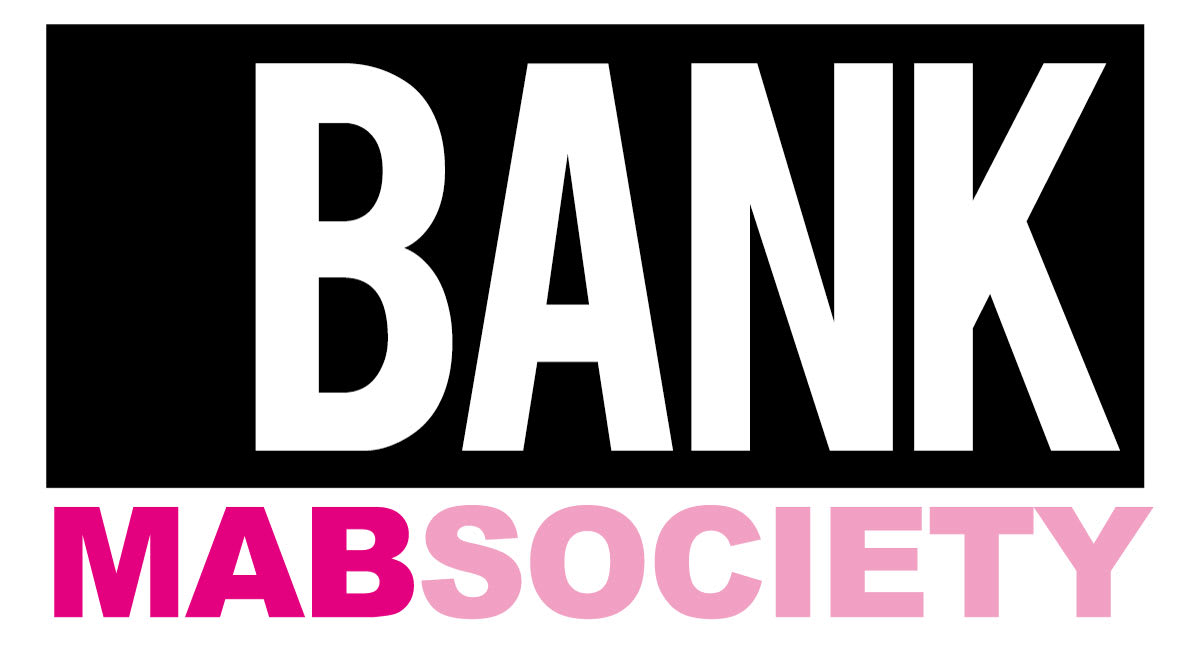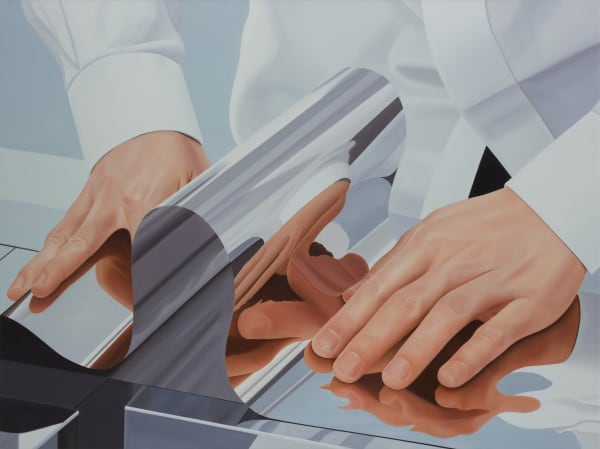Liang Hao: Gesture and Speech
Past exhibition
Overview
It is always the same hands, reaching out from the edge of the canvas and opening up at the center of the painting. It is the hands that are in motion, palms up and fingers clenching – stretch, grip, hold, touch, press, cut, chop. The hand appears in sync with its reflections from every angle, on the surfaces of the objects which it approaches and comes into contact with, the ones that look just like reflective mirrors: neat geometric shapes, a curved surface that resembles a convex metalized film, the edge of a blade, the outer case of a lighter. These two hands – from the fingers, the back of the hands, the skin, to the curve of the nails, and the appropriately subtle muscle bulge-each part of them is well-proportioned, smoothly clean, and absolutely impeccable. However, they possess a sense of unreality. The two hands appear to stretch out from a world devoid of time, they move, but, in an uncanny fashion, their movement morphs into eternity. They look familiar but do not completely belong to us. The owner of the hands shrouds their identity in secrecy. This pair of hands reaches out to greet our eyes in such a manner, gently caressing the realms of the sensorial, the concrete and the real with their distinct gestures. It exists somewhere higher up, like an idea-hand. These are the hands in a painting. This is a painting about hands.
Always, we see these two hands in Liang Hao's paintings. Always, these hands enter the canvas plane as if alluding in their own way to the artist's laborious efforts that are invisible behind the canvas. The secret of the hands also contains the secret of the painter. Without this connection, on what basis do we laud the master hand? Unexpectedly by chance, a viewer of the painting lets out a gasp of admiration, which deeply moves the heart of our artist: the word used to compliment skills is also the very subject of this technique. The skilled hand. Doing things with two hands means an operation, with the operated being a tool or instrument. Hands are valued as they are because they open the door for artistry, invention and techniques, as Bernard Stiegler stated. Hands teach human beings to conquer space, weight, density and quantity. Hands give form to a new world and leave its imprint wherever it has been.
The hand combats the material it is going to transform and wrestles with the form it is going to alter. This is what Henri Focillon said. But Liang Hao employs his hands--after the first draft on canvas, he will cover, polish and conceal the two hands as well as all the traces of their labor, again and again -- to keep recollecting and beckoning another pair of hands. The hands in a painting stand on a slightly higher ground above the hands in reality. At the same time, for the artist, they represent the ideal hands which never stop achieving a new pinnacle of technique. These hands pass from one painting to another, driving the development of an ever-evolving image and fueling its circulation, movement, transformation and regeneration on these continuous, repetitive and mutually echoing surfaces. The painter's work thus skillfully traces the infinite process of man's imitation of nature in a limited sequence of images.
So the hands appear on an inexplicable surface, one that integrates canvas (its material entity), operation console (its image) and interface (its meaning) into a triple plane. Within the limited dimension of the frame, it is cropped into a section which resides somewhere between a laboratory tabletop and a surgical table. Here, the two hands handle, assemble, reorganize and define their objects. Our gaze follows and adheres to the movements of the hands, attaching great attention, even obsession to these objects: the hands press against a stack of books, showing the marks they left as the books were placed away and put on top of each other, as well as the information hinted in the title on the book spines; the hands leaf through the opened pages, pointing at another pair of hands that rises from the surface, those that are painted by Caravaggio and reach for fruit; the hands grip corals, as if laying hold of a miniature model of a microcosm, a porous, winding and nested universe, and the shadow it casts onto the canvas plane; the field between two hands, the glossy, continuous geometric shapes, the mirrored maze reflected on its surface, a magnetic field, the field between vector and motion; the hands on a tabletop squash a piece of metal from both sides, making its surface into an arched Ω letter, the last one in the Greek alphabet. It made an appearance in God's words from the Book of Revelation and described itself, "I am the Alpha and the Omega, the First and the Last, the Beginning and the End." Then, is the artist depicting and implying God's hands here? Can we understand the movement of the hands as a gesture to define the world? In the absolute brightness without a shadow, the hands have created the last letter, so that things are bestowed with their existence and order. Meanwhile, the artist's hands wander on this surface compounded by the imaginary and the real, picture and canvas, image and linguistics. By painting themselves, the two hands take us back to the original instigate, the moment when external and internal worlds first became linked, as well as their countless potential variants. A world made by the coalescence and metaphors of corals, continuously mirrored images, a self-referential maze of symbols. A Baroque universe of possibilities. Thoughts glide, generate, fissure and proliferate in endless creases. The actions of folding and unfolding alternate repetitively, and thus the inside goes out and outside in, boundaries dissolve. This is a world defined by the painter's hand, a world that belongs to painting, ambiguity, a world of the master hand.
Always, we see these two hands in Liang Hao's paintings. Always, these hands enter the canvas plane as if alluding in their own way to the artist's laborious efforts that are invisible behind the canvas. The secret of the hands also contains the secret of the painter. Without this connection, on what basis do we laud the master hand? Unexpectedly by chance, a viewer of the painting lets out a gasp of admiration, which deeply moves the heart of our artist: the word used to compliment skills is also the very subject of this technique. The skilled hand. Doing things with two hands means an operation, with the operated being a tool or instrument. Hands are valued as they are because they open the door for artistry, invention and techniques, as Bernard Stiegler stated. Hands teach human beings to conquer space, weight, density and quantity. Hands give form to a new world and leave its imprint wherever it has been.
The hand combats the material it is going to transform and wrestles with the form it is going to alter. This is what Henri Focillon said. But Liang Hao employs his hands--after the first draft on canvas, he will cover, polish and conceal the two hands as well as all the traces of their labor, again and again -- to keep recollecting and beckoning another pair of hands. The hands in a painting stand on a slightly higher ground above the hands in reality. At the same time, for the artist, they represent the ideal hands which never stop achieving a new pinnacle of technique. These hands pass from one painting to another, driving the development of an ever-evolving image and fueling its circulation, movement, transformation and regeneration on these continuous, repetitive and mutually echoing surfaces. The painter's work thus skillfully traces the infinite process of man's imitation of nature in a limited sequence of images.
So the hands appear on an inexplicable surface, one that integrates canvas (its material entity), operation console (its image) and interface (its meaning) into a triple plane. Within the limited dimension of the frame, it is cropped into a section which resides somewhere between a laboratory tabletop and a surgical table. Here, the two hands handle, assemble, reorganize and define their objects. Our gaze follows and adheres to the movements of the hands, attaching great attention, even obsession to these objects: the hands press against a stack of books, showing the marks they left as the books were placed away and put on top of each other, as well as the information hinted in the title on the book spines; the hands leaf through the opened pages, pointing at another pair of hands that rises from the surface, those that are painted by Caravaggio and reach for fruit; the hands grip corals, as if laying hold of a miniature model of a microcosm, a porous, winding and nested universe, and the shadow it casts onto the canvas plane; the field between two hands, the glossy, continuous geometric shapes, the mirrored maze reflected on its surface, a magnetic field, the field between vector and motion; the hands on a tabletop squash a piece of metal from both sides, making its surface into an arched Ω letter, the last one in the Greek alphabet. It made an appearance in God's words from the Book of Revelation and described itself, "I am the Alpha and the Omega, the First and the Last, the Beginning and the End." Then, is the artist depicting and implying God's hands here? Can we understand the movement of the hands as a gesture to define the world? In the absolute brightness without a shadow, the hands have created the last letter, so that things are bestowed with their existence and order. Meanwhile, the artist's hands wander on this surface compounded by the imaginary and the real, picture and canvas, image and linguistics. By painting themselves, the two hands take us back to the original instigate, the moment when external and internal worlds first became linked, as well as their countless potential variants. A world made by the coalescence and metaphors of corals, continuously mirrored images, a self-referential maze of symbols. A Baroque universe of possibilities. Thoughts glide, generate, fissure and proliferate in endless creases. The actions of folding and unfolding alternate repetitively, and thus the inside goes out and outside in, boundaries dissolve. This is a world defined by the painter's hand, a world that belongs to painting, ambiguity, a world of the master hand.
Installation Views
Works
-
 Liang Hao 梁浩, The One Who Makes the Last Letter of the Alphabet 制造最后一个字母的人, 2022
Liang Hao 梁浩, The One Who Makes the Last Letter of the Alphabet 制造最后一个字母的人, 2022 -
 Liang Hao 梁浩 , When You Look at Caravaggio's Paintings, You will See a Lot of Gestures, A Quote From "The Fortune Teller (1596) "当你观看卡拉瓦乔的绘画时,你会看到许多手势,对《The Fortune Teller》(1596)的引用, 2022
Liang Hao 梁浩 , When You Look at Caravaggio's Paintings, You will See a Lot of Gestures, A Quote From "The Fortune Teller (1596) "当你观看卡拉瓦乔的绘画时,你会看到许多手势,对《The Fortune Teller》(1596)的引用, 2022 -
 Liang Hao 梁浩 , HOTEL BEAUNIER 博尼埃街道的旅馆, 2022
Liang Hao 梁浩 , HOTEL BEAUNIER 博尼埃街道的旅馆, 2022 -
 Liang Hao 梁浩 , HOTEL BEAUNIER, Morning 博尼埃街道的旅馆,上午, 2022
Liang Hao 梁浩 , HOTEL BEAUNIER, Morning 博尼埃街道的旅馆,上午, 2022
-
 Liang Hao 梁浩 , HOTEL BEAUNIER, Room for Tourists 博尼埃街道的旅馆,游客的房间, 2022 - 2023
Liang Hao 梁浩 , HOTEL BEAUNIER, Room for Tourists 博尼埃街道的旅馆,游客的房间, 2022 - 2023 -
 Liang Hao 梁浩, HOTEL BEAUNIER, The Opposite Side of The Image 博尼埃街道的旅馆,图像中的另一边, 2022
Liang Hao 梁浩, HOTEL BEAUNIER, The Opposite Side of The Image 博尼埃街道的旅馆,图像中的另一边, 2022 -
 Liang Hao 梁浩, Knife in Hand, Gesture of Grasping 手中刀, 掌握的姿势, 2022
Liang Hao 梁浩, Knife in Hand, Gesture of Grasping 手中刀, 掌握的姿势, 2022 -
 Liang Hao 梁浩 , Bitter Time Than These 人的境况,对卡拉瓦乔《Boy Bitten by a Lizard》(1593/94)的引用, 2022
Liang Hao 梁浩 , Bitter Time Than These 人的境况,对卡拉瓦乔《Boy Bitten by a Lizard》(1593/94)的引用, 2022











